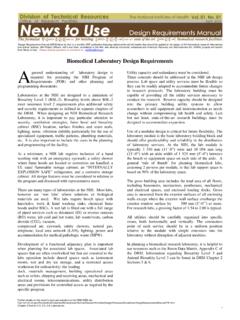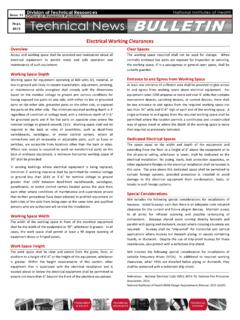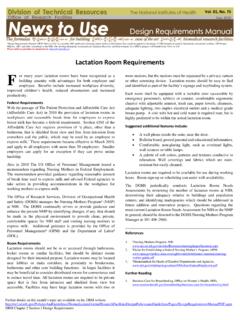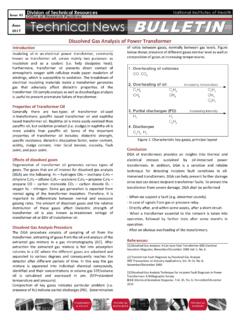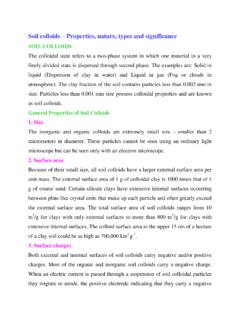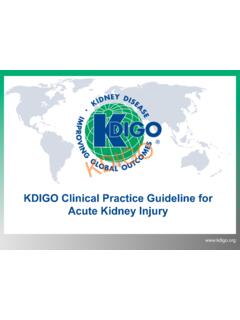Transcription of Laboratory Water - orf.od.nih.gov
1 Laboratory Water Its Importance and Application March, 2013 Table of Contents OVERVIEW .. 3 WHAT ARE COMMON Water CONTAMINANTS? .. 3 HOW DO WE MEASURE CONTAMINANTS IN Water ? .. 4 WHAT DOES LAB Water GRADE MEAN AND WHY DOES IT MATTER? .. 6 Water TREATMENT METHODOLOGIES .. 9 DISTILLATION .. 9 FILTRATION METHODS .. 9 DEIONIZATION .. 10 ELECTRODEIONIZATION .. 10 ADSORPTION .. 10 ULTRAVIOLET OXIDATION .. 10 HOW CENTRAL PURIFIED Water IS PRODUCED AND DESIGN OPTIONS .. 11 THE BEST SOLUTION .. 13 MONITORING Water PURITY .. 16 Water APPLICATIONS .. 17 SUMMARY .. 21 REFERENCES .. 22 Overview We often take Water quality for granted in daily life and in our work. If we work in a Laboratory , we may be very conscious of the need for reagent grade Water (RGW) for our Laboratory experiments and animal Water in order to reduce the risk of scientific variability or to prevent bacterial disease respectively, yet we fail to consider the quality of the Water we use in our equipment.
2 We also might not be aware of the different grades of Water that are available, the appropriate Water grade applications or the cost to obtain the desired Water grade. Inattention to Water quality in the lab can result in compromised experimental results, contaminated reagents or damaged equipment. Biomedical research, medical, and design professionals should become familiar with and apply the Water grade most applicable to their needs. The Division of Technical Resources (DTR), Office of Research Facilities (ORF) has written several articles about Water quality that may be of interest. Policies and Guidelines pages DRM_News_to_Use Water is known as the universal solvent because more substances (not all substances) dissolve in Water to varying degrees than in any other solvent.
3 This is due to the unique polarity and hydrogen bonds of the Water molecule. The same unique molecular properties of Water account for its ability to react with neutral organic molecules and establish hydrogen bonding with other molecules. For this reason, Water quality is crucial in the Laboratory because wherever Water is required, its reactivity must be taken into account. Water is easily contaminated by chemical solids, gases, vapors and ions that leach from conduit lines and containers. These may include sodium and silica from glass, plasticizers and ions from piping, microbial species and their endotoxins, as well as particulate contaminants. (Millipore, ) Soluble organic contaminants can even be introduced from deionizer resins used in the treatment process, especially if inadequate resins are selected or resins were previously contaminated.
4 To avoid the risk of contamination and ensure appropriate economies, centralized Laboratory Water systems should be designed to meet the process or product Water (PW) grade necessary for the most common applications, and to provide quality feedwater suitable for final polishing to serve ultrapure applications, such as typically required for various analytical applications. What are common Water contaminants? Natural or tap Water contains many substances that if left untreated may react or catalyze reactions in undesired ways. Cations such as sodium, calcium, magnesium or iron; anions such as bicarbonate, chloride and sulfate; and inorganic ions, are found in tap Water . Dissolved biological organic molecules, gases such as nitrogen, oxygen and carbon dioxide as well as hard and soft particulates and colloids may be introduced into the tap Water from any number of sources.
5 Volatile organics such as lower hydrocarbon trace pollutants from farm Water runoff and industrial pollution, and contaminants introduced as a consequence of treatment processes such as trihalomethanes (THMs) as a byproduct of chlorination may be present. Although many bacteria, viruses, and cysts such as giardia and cryptosporidium found in tap Water are killed or inactivated by the local chlorination process, microbial by-products and cellular fragments such as pyrogens, nucleases, alkaline phosphatase and endotoxins Page 3 will not necessarily be removed and can proliferate in biofilms. A number of contaminants may be present that are not regulated or tested in the course of municipal potable Water treatment and distribution, yet are detrimental to experimental processes that require precision, high sensitivity and resolution and instrumental operation and longevity.
6 How do we measure contaminants in Water ? Resistivity and conductivity are concepts to be familiar with when it comes to Water purity. Resistivity is the tendency of Water without ions to resist conducting electricity. The unit of measure is megohmcentimeter (M -cm), and varies with temperature. The theoretical maximum is to M -cm at 25 C. The higher the ionic content, the lower the resistivity and conversely, the lower the ionic content, the higher the resistivity. In ultrapure Water systems this value is determined using an in-line meter (ThermoScientific, 2009). Resistivity measurements taken upstream in a system prior to subsequent treatments such as UV, fine filtration, or even exposure to air, while important to monitoring certain treatment processes, may not be completely indicative of the final product Water s ionic content.
7 Conductivity is the tendency of Water that contains ions to conduct electricity. The unit of measure is the Siemen(S), microsiemens/centimeter ( S/cm) or micromho/cm. The measurement is used to measure feed Water and lower qualities of treated Water . The more ions present in the Water , the higher the conductivity. This is measured by a conductivity meter (ThermoScientific, 2009), and for accuracy must be taken on-line. Conductivity increases with temperature so values are reported as compensated at 25 C whereas resistivity is the inverse of conductivity and is expressed in M -cm@ 25 C (Riley, 2012). Measurement of ionic contamination is not in itself indicative of pure Water . A number of contaminants must also be considered, including microbial and organic factors.
8 An example to illustrate this point is the dissolution of 1,000 ppb of sucrose in theoretically pure Water , while still achieving resistivity approaching M -cm at 25 C (LCGC North America, 2005). Further, certain ionic contaminants may lower resistivity, yet the result may not be indicative of poor Water quality. For example, as little as 10 to 15 ppb of CO2 from clean air could cause the resistivity of M -cm Water to drop to as little as 10 M -cm (at 25 C). Limitations in accuracy of common instrumentation (even on-line type) as Water approaches the theoretical levels of purity are often beyond that present in many Laboratory Water systems. Total Organic Carbon (TOC) is a measure of the organic contaminants found in Water . The unit of measure is parts per million (ppm) or parts per billion (ppb).
9 High levels of TOC are indicative of organic contaminants, many of which may also serve as nutrients for microorganisms and be indicative of other contaminants. While elevated TOC readings do not identify the specific contaminant, a TOC reading when used along with conductivity and microbial parameters is an excellent qualitative indicator. Feedwater system TOC levels in the range of 200 ppb (and certainly below 500 ppb) could be considered practically reasonable feed Water quality for central systems subject to final polishing. The best high Page 4 purity Water (after polishing) should be in the 1-5 ppb range, and such low TOC levels can be critical for some applications (such as HPLC). High-performance liquid chromatography (HPLC) {sometimes referred to as high-pressure liquid chromatography}, is a chromatographic technique used to separate a mixture of compounds in analytical chemistry and biochemistry with the purpose of identifying, quantifying or purifying the individual components of the mixture.
10 Typically when measuring TOC levels required of centralized feedwater systems, properly conducted off-line measurement at regular intervals (such as quarterly) is acceptable; however where highly sensitive TOC restrictions are required (such as <50ppb), on-line measurement should be performed. There are practical limits to the accuracy of reasonably economic TOC instrumentation, and if a particular contaminant is of concern, more direct testing for that contaminant may be required. As potable Water is further treated to achieve high purity for scientific applications, residual disinfectants are removed leaving distribution systems vulnerable to microbial colonization and biofilms. If left unchecked, the microbial qualities can rapidly deteriorate below potable Water standards and a variety of contaminants most notably gram negative bacteria, fungi, algae, endotoxins and cellular waste products can reduce Water quality, interfere with treatment processes, and reduce removal efficiency.
